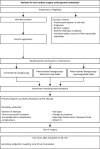Conventional versus video-assisted laryngoscopy for perioperative endotracheal intubation (COVALENT) - a randomized, controlled multicenter trial
- PMID: 37072702
- PMCID: PMC10111720
- DOI: 10.1186/s12871-023-02083-3
Conventional versus video-assisted laryngoscopy for perioperative endotracheal intubation (COVALENT) - a randomized, controlled multicenter trial
Abstract
Background: Data on the routine use of video-assisted laryngoscopy in peri-operative intubations are rather inconsistent and ambiguous, in part due to small populations and non-uniform outcome measures in past trials. Failed or prolonged intubation procedures are a reason for relevant morbidity and mortality. This study aims to determine whether video-assisted laryngoscopy (with both Macintosh-shaped and hyperangulated blades) is at least equal to the standard method of direct laryngoscopy with respect to the first-pass success rate. Furthermore, validated tools from the field of human factors will be applied to examine within-team communication and task load during this critical medical procedure.
Methods: In this randomized, controlled, three-armed parallel group design, multi-centre trial, a total of more than 2500 adult patients scheduled for perioperative endotracheal intubation will be randomized. In equally large arms, video-assisted laryngoscopy with a Macintosh-shaped or a hyperangulated blade will be compared to the standard of care (direct laryngoscopy with Macintosh blade). In a pre-defined hierarchical analysis, we will test the primary outcome for non-inferiority first. If this goal should be met, the design and projected statistical power also allow for subsequent testing for superiority of one of the interventions. Various secondary outcomes will account for patient safety considerations as well as human factors interactions within the provider team and will allow for further exploratory data analysis and hypothesis generation.
Discussion: This randomized controlled trial will provide a solid base of data in a field where reliable evidence is of major clinical importance. With thousands of endotracheal intubations performed every day in operating rooms around the world, every bit of performance improvement translates into increased patient safety and comfort and may eventually prevent significant burden of disease. Therefore, we feel confident that a large trial has the potential to considerably benefit patients and anaesthetists alike.
Trial registration: ClincalTrials.gov NCT05228288.
Protocol version: 1.1, November 15, 2021.
Keywords: Airway management; Anaesthesiology; Human factors; Intubation; Laryngoscopy; Patient safety; Video-assisted laryngoscopy.
© 2023. The Author(s).
Conflict of interest statement
The authors declare no competing interests.
Figures
References
-
- Timmermann A, Böttiger BW, Byhan C, Dörges V, Eich C, Gräsner JT, et al. S1-Leitlinie: Prähospitales Atemwegsmanagement (Kurzfassung) Anästhesiol Intensivmedizin. 2019;60:316–336.
Publication types
MeSH terms
Associated data
LinkOut - more resources
Full Text Sources
Medical
Miscellaneous



